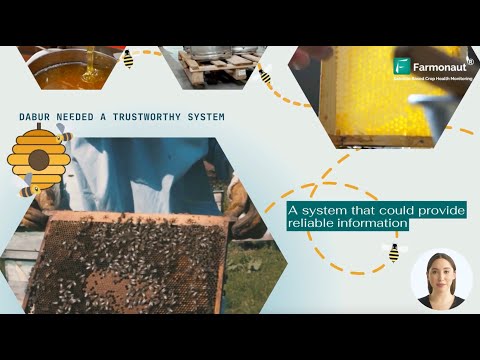Revolutionizing Washington: Justice Department’s Proposed Restructuring and Its Impact on Federal Agencies
“The Justice Department’s restructuring plan proposes merging two major agencies: the DEA and the ATF.”
“The proposed changes could affect thousands of federal prosecutors and multiple legal divisions across the Justice Department.”
In a sweeping move that has sent shockwaves through Washington and beyond, the Justice Department is considering a major restructuring that could fundamentally alter the landscape of federal law enforcement and legal operations. We at Farmonaut, while primarily focused on revolutionizing agriculture through technology, recognize the far-reaching implications of such changes on various sectors, including the agricultural industry. As we delve into this topic, we’ll explore how these proposed alterations could reshape the federal government’s approach to law enforcement, legal proceedings, and community relations.
The Scope of Justice Department Restructuring
The proposed restructuring of the Justice Department is not merely a minor administrative shuffle; it represents a significant overhaul of how federal law enforcement operates in the United States. At the heart of this proposal is the potential merger of two major agencies: the Drug Enforcement Administration (DEA) and the Bureau of Alcohol, Tobacco, Firearms and Explosives (ATF). This consolidation alone would mark a historic shift in how the federal government tackles issues related to drugs, firearms, and other controlled substances.

But the changes don’t stop there. The proposal outlines drastic alterations to various divisions within the department, including:
- Revamping the public integrity sections
- Scaling back foreign fraud investigations
- Closing the community relations office
- Consolidating legal divisions
- Reassigning federal prosecutors across the country
These changes align with broader government downsizing initiatives and could lead to a substantial shift in how the Justice Department operates on a day-to-day basis. The implications of this restructuring extend far beyond the walls of government buildings in Washington; they have the potential to affect law enforcement strategies, legal proceedings, and community engagement nationwide.
The DEA and ATF Merger: A Closer Look
The proposed merger of the Drug Enforcement Administration and the Bureau of Alcohol, Tobacco, Firearms and Explosives is perhaps the most headline-grabbing aspect of this restructuring plan. Both agencies have long histories and distinct missions, but they often find their work overlapping, especially in cases involving both drugs and firearms.
The DEA, with its approximately 10,000 employees, focuses on combating drug smuggling and use within the United States. The ATF, smaller with around 5,000 staff members, is responsible for enforcing federal laws related to firearms, explosives, arson, and alcohol and tobacco diversion.
Proponents of the merger argue that combining these agencies could lead to more efficient operations, especially in cases where drug and gun crimes intersect. However, critics worry about potential issues such as:
- Mission drift
- Resource allocation challenges
- Cultural clashes between the two agencies
- Potential loss of specialized expertise
It’s worth noting that such a merger would likely require congressional approval, adding another layer of complexity to its implementation.
Impact on Federal Law Enforcement Reform
The proposed restructuring goes beyond just merging agencies; it represents a fundamental shift in how federal law enforcement might operate in the future. By consolidating offices and reassigning prosecutors, the Justice Department aims to streamline operations and potentially reduce costs. However, these changes could also have significant impacts on how various types of crimes are investigated and prosecuted.
For instance, the scaling back of foreign fraud investigations could alter how the U.S. approaches white-collar crime with international dimensions. Similarly, changes to the public integrity sections could affect how corruption cases involving public officials are handled.
These shifts in focus and resources could lead to a ripple effect across various industries and sectors. For example, in the agricultural sector, changes in how fraud investigations are conducted could impact cases related to agricultural subsidies or international trade disputes. At Farmonaut, we understand the importance of regulatory compliance and transparency in agriculture, which is why we offer solutions like our blockchain-based traceability system. This technology helps ensure transparency and compliance in agricultural supply chains, potentially easing the burden on law enforcement agencies in monitoring certain aspects of the industry.
Community Relations and Public Trust
One of the more controversial aspects of the proposed restructuring is the potential closure of the community relations office. This office was established in response to a series of high-profile police shootings and was intended to improve relations between law enforcement and the communities they serve.
The closure of this office could signal a shift in how the federal government approaches community policing and public trust issues. Critics argue that this move could undermine efforts to build stronger relationships between law enforcement and communities, particularly in areas with historically tense relations.
However, proponents of the restructuring might argue that community relations efforts could be more effectively handled at the local level or integrated into other departments. Regardless of the outcome, this change highlights the ongoing debate about the role of federal agencies in local law enforcement matters.
Implications for Legal Divisions and Federal Prosecutors
The proposed restructuring also includes significant changes to how legal divisions within the Justice Department operate. This includes:
- Consolidating various legal divisions into a single office
- Reassigning federal prosecutors to U.S. attorney’s offices around the country
- Closing several offices, including antitrust offices in Chicago and San Francisco, and environmental offices in Denver, Seattle, San Francisco, and Sacramento
These changes could have far-reaching effects on how federal cases are prosecuted and how legal expertise is distributed across the country. For instance, the reassignment of federal prosecutors could lead to a more decentralized approach to case management, potentially bringing federal legal resources closer to the communities they serve.
However, there are concerns about the potential loss of specialized expertise that comes with consolidating divisions and closing offices. Critics worry that this could lead to a decrease in the effectiveness of federal prosecutions in certain areas of law.

The Reasoning Behind the Proposals
The Justice Department’s restructuring proposal is part of a broader initiative to downsize and streamline federal operations. This aligns with the current administration’s goals of reducing government spending and improving efficiency. However, critics argue that the cost-saving rationale may be masking deeper political motivations.
Some of the key reasons cited for these changes include:
- Improving operational efficiency by consolidating overlapping functions
- Reducing bureaucratic overhead
- Adapting to changing law enforcement priorities
- Addressing perceived inefficiencies in current organizational structures
It’s important to note that while these changes are significant, they are still in the proposal stage. The Justice Department is seeking feedback from employees and stakeholders before moving forward with implementation.
Potential Challenges and Criticisms
As with any major organizational overhaul, the proposed Justice Department restructuring faces several challenges and criticisms:
- Concerns about the loss of specialized expertise in certain areas of law enforcement and prosecution
- Fears that the merger of the DEA and ATF could lead to a reduction in resources for both drug and firearms enforcement
- Worries about the impact on ongoing investigations and cases
- Questions about the long-term effects on federal law enforcement capabilities
- Concerns about the potential politicization of traditionally non-partisan offices
Additionally, there are logistical challenges to consider, such as the physical relocation of offices and personnel, the integration of different agency cultures, and the potential need for new training and equipment.
The Role of Congress and Oversight
While the Justice Department has significant autonomy in how it organizes its internal operations, many of the proposed changes, particularly the merger of the DEA and ATF, would likely require congressional approval. This adds another layer of complexity to the restructuring process.
Congressional oversight will play a crucial role in how these proposals move forward. Key considerations for lawmakers might include:
- The potential impact on law enforcement effectiveness
- Budgetary implications of the restructuring
- Ensuring proper checks and balances within the department
- Addressing concerns from various stakeholders, including law enforcement unions and civil rights organizations
The level of congressional involvement in this process could significantly influence the final shape of any restructuring efforts.
Implications for Various Sectors
While the Justice Department’s restructuring primarily affects law enforcement and legal operations, its ripple effects could be felt across various sectors. For instance, in the agricultural sector, changes in how certain types of fraud or environmental cases are handled could have significant implications.
At Farmonaut, we understand the importance of staying ahead of regulatory changes and ensuring compliance in agricultural operations. Our carbon footprinting tools help agribusinesses monitor and reduce their environmental impact, potentially easing compliance with evolving environmental regulations. Similarly, our crop loan and insurance verification services can assist in maintaining transparency and reducing fraud in agricultural financing, aligning with potential shifts in how financial crimes are investigated and prosecuted.
Looking Ahead: The Future of Federal Law Enforcement
As we consider the potential outcomes of this proposed restructuring, it’s clear that the landscape of federal law enforcement and legal operations could look very different in the coming years. Some potential long-term effects might include:
- A more integrated approach to tackling drug and firearms crimes
- Increased efficiency in federal prosecutions
- Potential shifts in how certain types of crimes are prioritized
- Changes in how federal law enforcement interacts with local communities
However, the success of these changes will largely depend on how effectively they are implemented and how well they adapt to the evolving needs of law enforcement and the justice system.
Comparative Analysis of Justice Department Restructuring
| Department/Agency | Current Structure | Proposed Changes |
|---|---|---|
| Drug Enforcement Administration (DEA) | Independent agency with ~10,000 employees | Merge with ATF; Estimated 15% reduction in overall staff |
| Bureau of Alcohol, Tobacco, Firearms and Explosives (ATF) | Independent agency with ~5,000 employees | Merge with DEA; Potential reorganization of duties |
| Public Integrity Sections | Centralized in Washington D.C. | Prosecutors reassigned to U.S. attorney’s offices nationwide |
| Foreign Fraud Investigations | Dedicated units for international cases | Scaled back operations; Focus shift to domestic cases |
| Community Relations Offices | Established post-police shooting incidents | Proposed closure; Functions potentially absorbed by other units |
| Legal Divisions | Multiple specialized divisions | Consolidation into a single office; Estimated 20% reduction in offices |
Conclusion: A Transformative Moment for Federal Justice
The proposed restructuring of the Justice Department represents a potentially transformative moment in the history of federal law enforcement and legal operations in the United States. While the full implications of these changes are yet to be seen, it’s clear that they could significantly alter how justice is administered at the federal level.
As we at Farmonaut continue to innovate in the agricultural sector, we recognize the importance of staying informed about these broader changes in government operations. Our commitment to transparency, efficiency, and compliance in agriculture aligns with many of the goals outlined in this restructuring proposal. Whether it’s through our fleet management solutions that help optimize agricultural operations or our large-scale farm management tools that promote efficient resource use, we’re dedicated to supporting a more effective and sustainable agricultural sector.
As this proposal moves forward, it will be crucial for all stakeholders – from government officials to industry leaders to community members – to engage in thoughtful dialogue about the future of federal law enforcement and justice in America. The outcomes of this restructuring could shape the landscape of federal operations for years to come, influencing everything from how crimes are investigated to how communities interact with law enforcement agencies.
FAQ Section
Q: What are the main changes proposed in the Justice Department restructuring?
A: The key changes include merging the DEA and ATF, reassigning federal prosecutors, consolidating legal divisions, scaling back foreign fraud investigations, and potentially closing the community relations office.
Q: Will these changes require congressional approval?
A: Some aspects, particularly the merger of the DEA and ATF, would likely require congressional approval. Other internal reorganizations might be implemented without legislative action.
Q: How might these changes affect local law enforcement?
A: The restructuring could change how federal agencies interact with local law enforcement, potentially affecting joint operations, resource allocation, and community policing strategies.
Q: What are the potential benefits of this restructuring?
A: Proponents argue it could lead to improved efficiency, reduced costs, and more effective law enforcement operations by eliminating overlapping functions and streamlining processes.
Q: What concerns have been raised about the proposed changes?
A: Critics worry about the potential loss of specialized expertise, reduced resources for certain types of investigations, and the impact on ongoing cases and community relations efforts.
Stay Informed with Farmonaut
As we continue to monitor these developments in federal restructuring, Farmonaut remains committed to providing cutting-edge solutions for the agricultural sector. Our technology not only helps farmers optimize their operations but also ensures compliance with evolving regulations.
To learn more about how Farmonaut can help you navigate the changing landscape of agriculture and technology, explore our solutions:
For developers interested in integrating our technology into their own solutions, check out our API and API Developer Docs.
Earn With Farmonaut: Join our Affiliate Program
Earn 20% recurring commission with Farmonaut’s affiliate program by sharing your promo code and helping farmers save 10%. Onboard 10 Elite farmers monthly to earn a minimum of $148,000 annually—start now and grow your income!
Farmonaut Subscriptions
As we navigate these changing times, Farmonaut remains dedicated to empowering farmers and agricultural businesses with cutting-edge technology and insights. Stay tuned for more updates on how changes in federal agencies might impact the agricultural sector, and how our solutions can help you stay ahead of the curve.





















